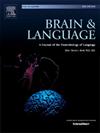Interactive and additive effects of word frequency and predictability: A fixation-related fMRI study
IF 2.3
2区 心理学
Q1 AUDIOLOGY & SPEECH-LANGUAGE PATHOLOGY
引用次数: 0
Abstract
The effects of word frequency and predictability are informative with respect to bottom-up and top-down mechanisms during reading. Word frequency is assumed to index bottom-up, whereas word predictability top-down information. Findings regarding potential interactive effects, however, are inconclusive. An interactive effect would suggest an early lexical impact of contextual top-down mechanisms where both variables are processed concurrently in early stages of word recognition. An additive effect, to the contrary, would suggest that contextual top-down processing only occurs post-lexically. We evaluated potential interactions between word frequency and predictability during silent reading by means of functional magnetic resonance imaging and simultaneous eye-tracking (i.e., fixation-related fMRI). Our data revealed exclusively additive effects. Specifically, we observed effects of word frequency and word predictability in left inferior frontal regions, whereas word frequency additionally exhibited an effect in the left occipito-temporal cortex. We interpret our findings in terms of contextual top-down processing facilitation.
词频和可预见性的交互和加性效应:一项与注视相关的功能磁共振成像研究。
词频和可预测性对阅读过程中自下而上和自上而下机制的影响具有信息性。假设词频是自下而上的索引,而词的可预测性是自上而下的信息。然而,关于潜在相互作用的发现尚无定论。互动效应表明上下文自上而下机制的早期词汇影响,其中两个变量在单词识别的早期阶段同时处理。相反,累加效应表明上下文自上而下的处理只发生在词汇之后。我们通过功能磁共振成像和同步眼动追踪(即注视相关的fMRI)评估了默读时词频和可预测性之间的潜在相互作用。我们的数据只显示了加性效应。具体来说,我们观察到词频和单词可预见性对左额叶下区有影响,而词频对左枕颞叶皮层也有影响。我们从情境自上而下的加工促进的角度来解释我们的发现。
本文章由计算机程序翻译,如有差异,请以英文原文为准。
求助全文
约1分钟内获得全文
求助全文
来源期刊

Brain and Language
医学-神经科学
CiteScore
4.50
自引率
8.00%
发文量
82
审稿时长
20.5 weeks
期刊介绍:
An interdisciplinary journal, Brain and Language publishes articles that elucidate the complex relationships among language, brain, and behavior. The journal covers the large variety of modern techniques in cognitive neuroscience, including functional and structural brain imaging, electrophysiology, cellular and molecular neurobiology, genetics, lesion-based approaches, and computational modeling. All articles must relate to human language and be relevant to the understanding of its neurobiological and neurocognitive bases. Published articles in the journal are expected to have significant theoretical novelty and/or practical implications, and use perspectives and methods from psychology, linguistics, and neuroscience along with brain data and brain measures.
 求助内容:
求助内容: 应助结果提醒方式:
应助结果提醒方式:


